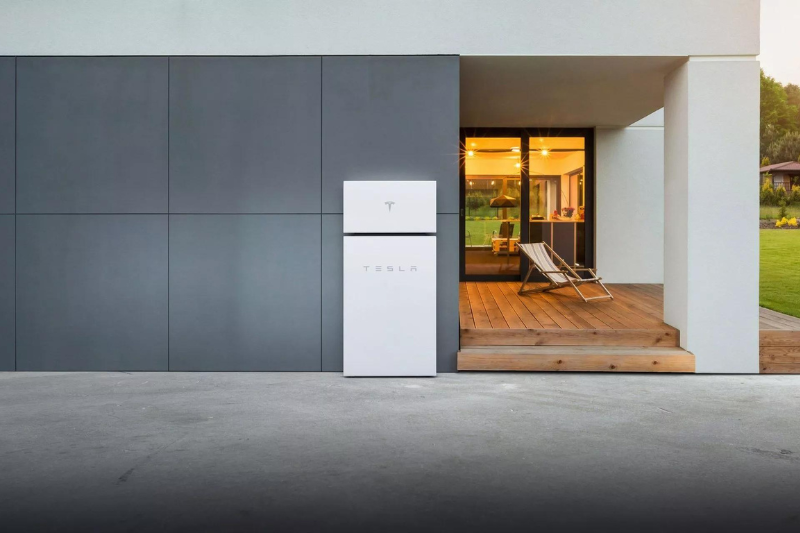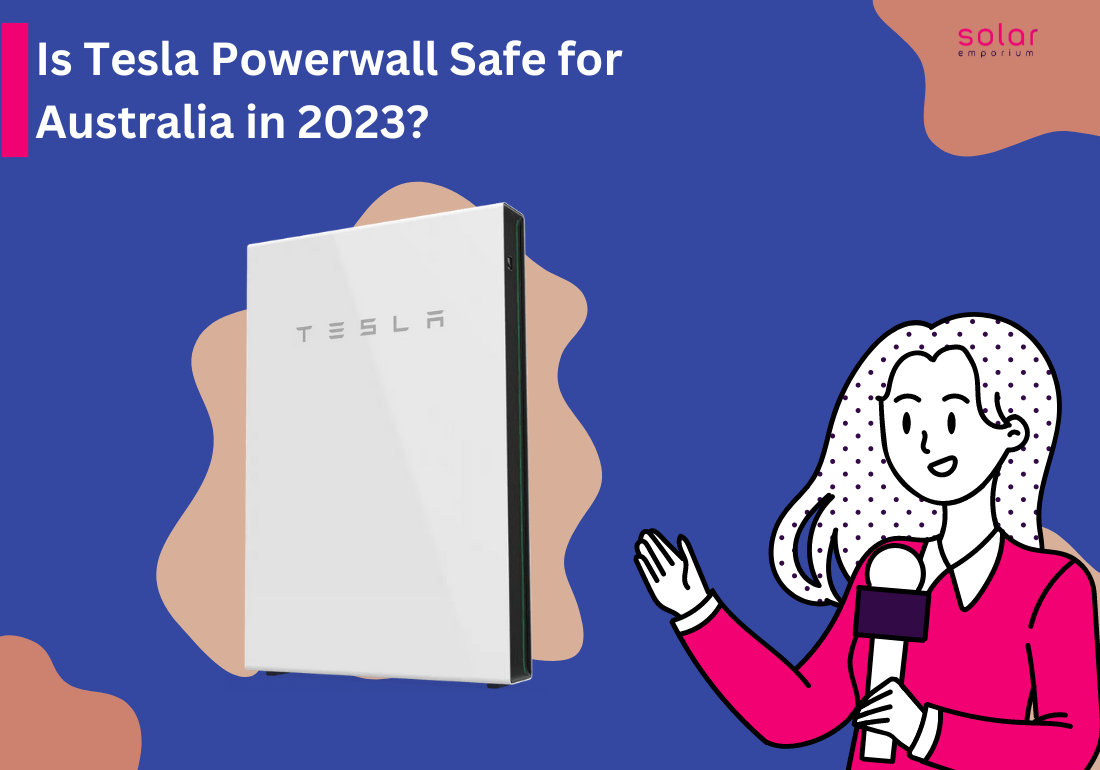The demand for renewable energy solutions is rising as we move towards a more sustainable future. One solution that has gained significant attention in Australia is the Tesla Powerwall.
But many Australians still have the same question. Is the Tesla Powerwall safe for Australia in 2023? And today, we’ll try to answer this question by examining the safety measures incorporated into the Tesla Powerwall.
Tesla Powerwall: A Brief Overview
The Tesla Powerwall is a rechargeable lithium-ion battery designed for energy storage. It’s primarily used to store solar energy from solar panels. The Powerwall provides backup power and even enables off-grid use.
How Does a Tesla Powerwall Work?
Simply put, your solar panels absorb sunlight and turn it into energy you can use in your home. This energy flows into your home to power your appliances. Any extra energy is stored in the Powerwall.
Additional electricity your system generates is delivered back to the grid once the Powerwall is wholly charged. Your Powerwall will offer electricity to power your home when the sun goes down and your solar panels are not producing energy.
The Powerwall’s sleek, compact design and advanced features have made it a popular choice among homeowners. But is the Tesla Powerwall safe for Australia? Let’s look at the safety measures.
Tesla Powerwall Safety Measures
Tesla has always prioritised safety in all its products, and the Powerwall is no exception. Here are some key safety measures that make the Powerwall a safe choice for Australians in 2023.

Built-in Thermal Management System: The Powerwall has a liquid thermal management system that maintains the battery’s temperature within safe limits. This feature is particularly important in Australia, where temperatures get harsh during summer.
Advanced Battery Management System: The Powerwall’s Battery Management System (BMS) continuously monitors the battery’s state, including voltage, current, and temperature. If the BMS detects abnormal conditions, it can disconnect the battery to prevent damage or safety risks.
Strong Exterior: The Powerwall’s outer shell is designed to withstand harsh weather conditions, making it suitable for outdoor installation. It’s rated for water and dust resistance, ensuring it can handle Australia’s diverse climate.
Safe Connection: The Powerwall uses lithium-ion NMC (Nickel Manganese Cobalt), which is known for its safety and stability. This connection reduces the risk of thermal runaway, a common safety concern with lithium-ion batteries.
Automatic Updates: Tesla regularly updates the Powerwall’s software to improve its performance and safety. These updates are delivered wirelessly. It ensures your Powerwall is always equipped with the latest safety features.
Emergency Shutdown: If it detects a fault or emergency, the Powerwall can automatically disconnect from the grid and shut down, preventing potential dangers.
So Is Tesla Powerwall Safe for Australia in 2023?
Given the safety measures incorporated into the Tesla Powerwall, it’s clear that Tesla has made significant efforts to ensure its product is safe for use.
The Powerwall’s built-in safety features and Tesla’s commitment to continuous improvement make it a safe choice for Australians in 2023.
However, it’s important to note that the safety of any energy storage system also depends on proper installation and usage.
Therefore, it’s recommended to have your Powerwall installed by a certified Tesla installer and to follow all usage guidelines provided by Tesla.
Is Tesla Powerwall/Home Battery Durable in Australia?
The Tesla Powerwall is designed to be durable and suitable for various climates, including the diverse weather conditions of Australia.
The Powerwall’s tough exterior is built to cope with harsh weather conditions, making it suitable for indoor and outdoor installation. It is water and dust resistance, ensuring it can handle Australia’s varied climate, from the hot, dry summers to the wet winters.
Moreover, the Powerwall has a built-in thermal management system that maintains the battery’s temperature within safe limits. This feature is particularly important in Australia, where temperatures can rise during summer.

However, it’s critical to note that several factors, including the frequency of use, the depth of discharge, and the local climate, can influence the lifespan and performance of any battery.
Therefore, while the Powerwall is designed to be durable, its actual lifespan in Australia may vary based on these factors.
But the Tesla Powerwall is built to be durable and well-equipped to handle the Australian climate, making it a reliable home battery solution for Australians.
What is the Tesla Powerwall Warranty?
The warranty for the Tesla Powerwall in Australia is divided into two categories. The first category includes individuals connected to the grid and utilising solar power for charging and grid energy in areas with time-of-use tariffs.
The warranty lasts ten years for these users and offers unlimited cycles. While endless cycles may seem impressive, it’s important to note that this only applies to those using low-cost off-peak grid electricity to charge their batteries.
The second category includes off-grid users who can charge their Powerwall using an approved generator. However, due to Tesla’s stringent guidelines, individuals will likely fall into this warranty category.
Tesla does permit Powerwall 2 to be charged via non-solar means, such as approved generators. Still, the warranty may be limited to 10 years or 37.8MWh of throughput energy, whichever comes first.
If the system does not have a better design, leading to daily usage of 100% of the battery’s capacity, the warranty could expire after approximately seven years and eight months.
This assumes the battery is cycled once a day, and its capacity remains unchanged from when it was new. Unfortunately, all lithium-ion batteries degrade over time and with use.
The warranty guarantees that Tesla Powerwall will retain at least 70% of their original capacity by the end of the ten-year warranty period.
But is the Tesla Powerwall a Worthy Investment?

The Tesla Powerwall, an energy storage system, has recently gained popularity. It allows residential and commercial users to store energy generated from solar panels or other renewable sources for later use, reducing reliance on the traditional grid.
The benefits include increased reliability, reduced electricity bills, and enhanced control over energy consumption.
The Powerwall system comprises an inverter and a battery. The inverter converts the direct current (DC) produced by solar panels or other renewable sources into alternating current (AC).
It can power your appliances or be fed back into the grid for credits. The battery stores this energy, providing power during periods of no sun or utility interruptions, making it ideal for off-grid living and backup power during extended power outages.
Economically, the Powerwall offers several advantages. It can significantly reduce electricity bills as users can tap into stored energy instead of solely relying on their local utility provider.
Additionally, excess energy can be fed back into the grid for credits, further reducing future bills. If paired with solar panels, users can save more by relying on renewable resources for their electricity needs. This process can eliminate the need to purchase electricity from their local utility provider.
Considering all these factors, we can conclude that Tesla Powerwall is safe for Australian households. It is also a wise investment for a better and sustainable future.
The Tesla Powerwall is not only an innovative solution for renewable energy storage but also a safe one. Its advanced safety features make it a reliable choice for Australians seeking to utilise the power of renewable energy in 2023.
To purchase the Tesla Powerwall at a reasonable price, get a free quote from Solar Emporium today!
FAQs About Tesla Powerwall in Australia
The average lifespan of a Tesla Powerwall is around 20 years. However, this number can vary depending on how often you use your battery and how much of it you use.
Taking care of your Tesla Powerwall and not using it 100% daily could last up to 25+ years. But if you use its stored energy daily, the battery may last less time than expected.
It completely depends on the amount of solar power you need to store. It also depends on how many power outages happen in your area and how much you use the battery during that time.
We strongly urge you to contact us and get a free consultancy from our solar experts. We’ll then discuss your goals and average usage history to know how many Powerwall you need.
How long Tesla Powerwall will run in your home depends on how much energy you use with various appliances. With one Powerwall, you can power basic needs in your home for up to 12 hours. This capacity includes lights, electrical outlets, and small appliances.
We suggest installing the Powerwall in non-residential sections of your house, such as the garage or basement, to shield the battery from weather conditions.
If this isn’t feasible, outdoor installation is also an option. But harsh temperatures may affect its performance. Solar Emporium’s Solar specialists can guide you through the entire process.
Your Powerwall will activate during a power outage, and your home will seamlessly switch to battery power. It means keeping your devices charged and avoiding any potential issues.
Technically, yes, but to meet the energy demands of an average family, you require a substantial solar setup and multiple batteries.
Even if you remain grid-connected, a solar and battery system can drastically reduce your dependence on utility power, significantly saving your electricity bill.
It’s possible to achieve net-zero or even net-positive electricity usage without physically disconnecting from the grid, and it’s a more cost-effective approach.
We strongly discourage installing a Powerwall yourself due to the potential risks involved. A certified and experienced professional electrician should carry out the installation of a Powerwall or any other battery storage system.
Furthermore, to buy and install a Powerwall, you must be a Certified Tesla Powerwall Installer. Even if you purchase a Tesla Powerwall online, it will only be covered by a warranty if bought from and installed by a certified Installer.
The installation process for a Powerwall typically takes about a day. In most scenarios, we’ll set up the batteries simultaneously as your solar system, so there’s no additional waiting time.
However, availability is crucial – getting in line as soon as possible to secure your Powerwall is best.







